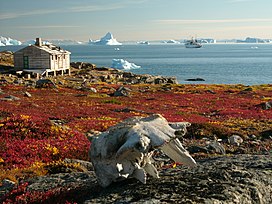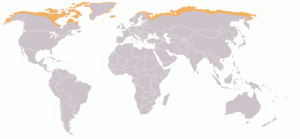
Back Toendra Afrikaans Tundra AN تندرة Arabic Tundra AST Tundra Azerbaijani Тундра Bashkir Tondra BAT-SMG Тундра Byelorussian Тундра BE-X-OLD Тундра Bulgarian
| Tundra | |
|---|---|
 Tundra in Greenland | |
 extent of the Arctic tundra | |
| Geography | |
| Area | 11,563,300[1] km2 (4,464,600 sq mi) |
| Climate type | ET |
In physical geography, tundra (/ˈtʌndrə, ˈtʊn-/) is a type of biome where tree growth is hindered by frigid temperatures and short growing seasons. There are three regions and associated types of tundra: Arctic tundra,[2] alpine tundra,[2] and Antarctic tundra.[3]
Tundra vegetation is composed of dwarf shrubs, sedges, grasses, mosses, and lichens. Scattered trees grow in some tundra regions. The ecotone (or ecological boundary region) between the tundra and the forest is known as the tree line or timberline. The tundra soil is rich in nitrogen and phosphorus.[2] The soil also contains large amounts of biomass and decomposed biomass that has been stored as methane and carbon dioxide in the permafrost, making the tundra soil a carbon sink. As global warming heats the ecosystem and causes soil thawing, the permafrost carbon cycle accelerates and releases much of these soil-contained greenhouse gases into the atmosphere, creating a feedback cycle that changes climate.
- ^ "Ecoregions". World Wildlife Fund. Archived from the original on 4 June 2011.
- ^ a b c "The Tundra Biome". The World's Biomes. University of California, Berkeley. Archived from the original on 22 July 2023. Retrieved 5 March 2006.
- ^ "Terrestrial Ecoregions: Antarctica". Wild World. National Geographic Society. Archived from the original on 5 August 2011. Retrieved 2 November 2009.